“A funny thing happened on the way to the Prerelease…”
In my last column, I had nothing but praise for
Dragonlord Dromoka, or “Blueslayer Dragon” as I’ve been wont to call it in my various ramblings. I’m generally not a fan of green/white in any
format, though I’ve been known to play my fair share of either of them – but with the ability to shut off opponents’ interaction on your turn and lifelink
on a commander besides, Dromoka got me to sit up and pay attention to Dragons of Tarkir for Commander. I had signed myself up for a midnight
Prerelease since that would be the only time I’d be able to find for gaming with the new cards this weekend, when they asked me a rather-obvious but (to
me) most curious question: which color?
I know this is not that unusual, as we’ve had “seeded packs” of one sort or another over and over now for a few years at this point, but I’ve missed more
Prereleases than I’ve made over that same period, so it meant I had to actually stop and think. The easy answer that has proven historically correct was
apparently not an option – over most Sealed Deck formats in general, the smart answer would be blue/white, but my local store was allowing players to
choose their color combination when they pre-registered, and many a mage had already logged their request to marginally improve their chances of opening
Narset Transcendent. After that, there were just biases to guide me – I won’t play green/white unless I have literally no other option, history likewise
guided me away from the trap that black/red frequently is, and looking at the cards in the set told me I didn’t want to be blue/black either. Instead of
playing complicated Magic, I looked forward to an entertaining late-late-late evening beating down, and realized after-the-fact that having marginally
improved my chances of opening a copy of Dragonlord Atarka to play with would have been far-and-away the correct decision, even over playing blue/white.
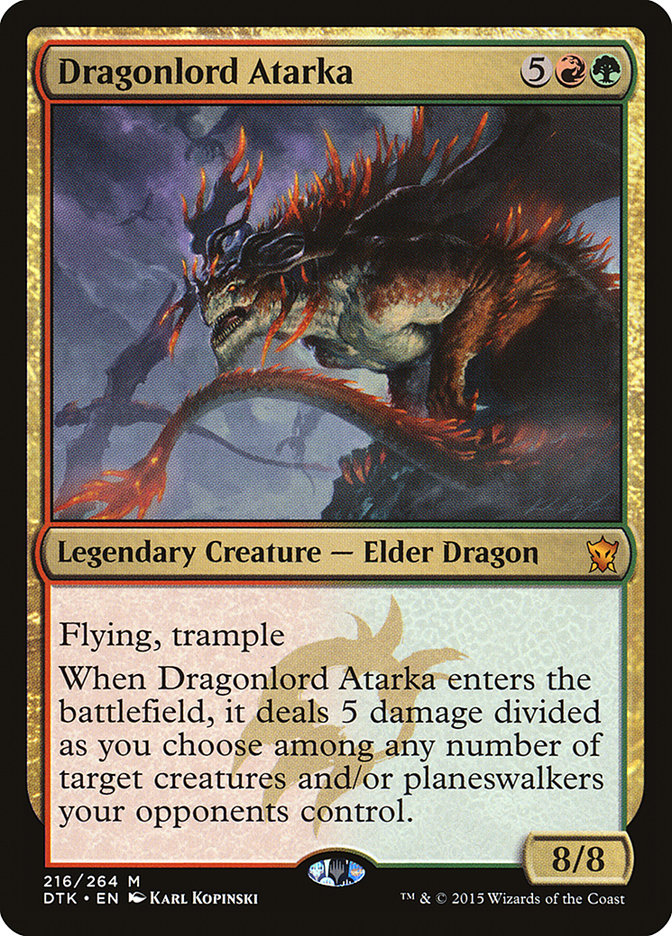
Not Gruul? Then die!
I wish I could say this was an informed decision upfront – like “I read Ari Lax’s article breaking down the commons and uncommons of Dragons of Tarkir and made a reasoned decision” – but really it was “can’t do U/W, refuse to do the other three, Okay! Red-green it is!” Nothing
complicated, just “let’s smash.”
And we did a fair amount of that. I wish I could say I did the maximum amount of that since my win rate at Prereleases over a very long time-span is
somewhere at or above 80%, but all it takes is one sketchy keep in game 3 to sour a match… and 3AM is notoriously a time for capricious mulligan
decisions. But when your deck has a lot of five-drops and even a fair amount of sixes, mulliganing on the play is absolutely atrocious, while keeping a
six-lander and hoping you will just never draw more is not unreasonable – merely wrong.
But what really inspired me happened in round one. I lost the first game in a squeaker, one of those games where everyone does everything right and you’d
have won if you were on the play, but you just weren’t. For game 2, I’m on the play and I see four lands and these three creatures:
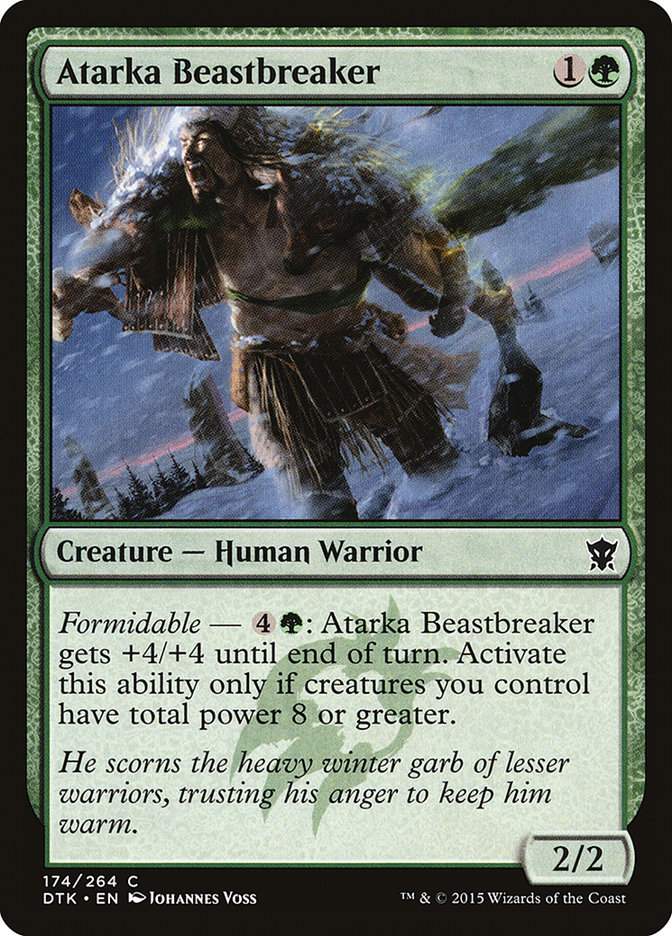
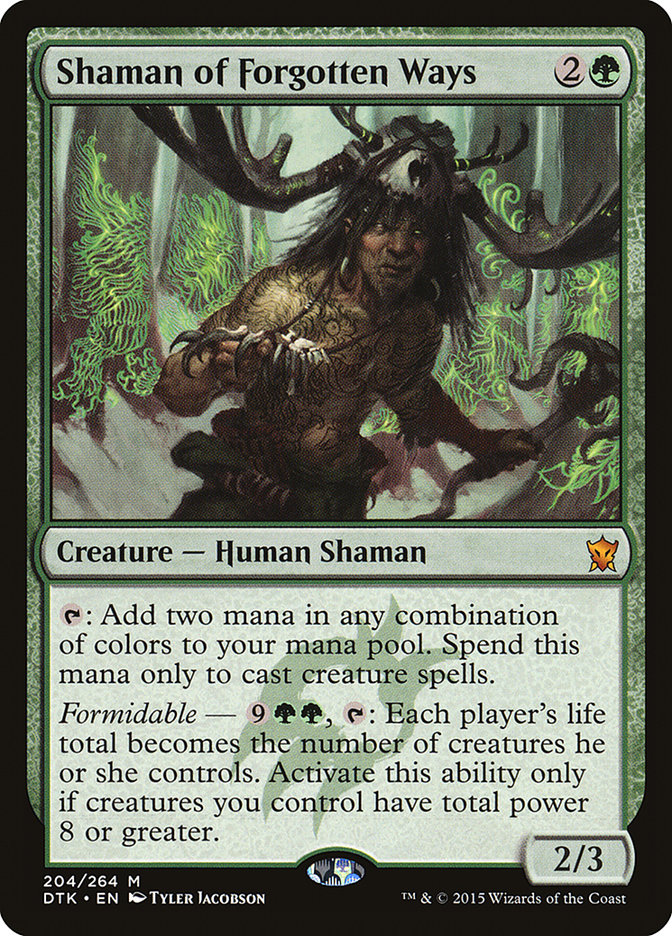

Needless to say, I was pretty excited. I’d hit Formidable real fast, and the six mana from when the Dragon attacks can turn Atarka Beastbreaker into a real
attacker, I could potentially pump it twice in one turn and get in for a whole lot of damage. Of course, you could figure the opponent would
probably block, but I was excited about the little ‘combo’ I had found in my opening hand. So on turn 2 I cast the Beastbreaker, but of course my opponent
also played a 2/2, so that plan was foiled right away. Turn 3 I cast Shaman of Forgotten Ways, and turn 4 I cast Savage Ventmaw, and somewhere around then
a lightbulb ticked on in my brain and said “try reading the cards, just in case.” Good thing I did, because on turn 5 I played my fifth land and swung for
lethal.
Yes, my opponent started the turn at 20. No, Atarka Beastbreaker didn’t attack and find some way to get both double strike and trample. All I did was learn
to count to eleven in the face of my opponent being tapped out with three creatures in play, none of which had flying – attack for four in the air, six mana from the Dragon and five from my lands equals enough to use the Biorhythm ability on the Shaman, you go to three and then get murdered. While this particular nasty
combo is not one I’d expect to run into often in Dragons of Tarkir-Fate Reforged Limited, relying as it does on a perfect curve, a mythic rare, and one very specific uncommon that is not actually that impressive, it is nonetheless entirely possible and might just happen sometimes.
As my opponent found out, with round one of the Prerelease being that “sometime.”
Dragons of Tarkir
is pretty darn exciting – for Limited, for Constructed, and even for us 99-card aficionados. As I shambled into bed at something around five in the
morning, I realized I wanted to play with Dragonlord Atarka even more than I’d first realized, and since I wasn’t lucky enough to get to at the Prerelease,
well, we’d just have to make a new Commander deck to make that happen!
Here I Rule
First thing my Dragonlord would need is some, ahem, Gruul turf. I like a manabase with a fair bit of complexity to it since I’d like to have my
mana do something in the later stages of the game, so I can get some spell-like function out of them and always have relevance rather than find myself sitting around without
anything to do or any cardboard to defend myself with. I knew that I didn’t want to get really ramp-y despite that being why most people play green
commanders, and with a seven-drop at the helm I’d be wanting to lean on some of the card-advantage land-searchers and a dash of card drawing, but mostly
synergy with Life from the Loam and Crucible of Worlds – either would turn the power level up to eleven, and one I could even Gamble for and not care, so
I’ll finally get to try that out and see how I like it. In basic concept I hate the card, but I also really love to Life from the Loam, so I’m
trying to get over my innate aversion and we’ll see what happens if I ever try and Gamble for literally any other card – I may turn out to hate it still.
Focusing on those meant enough fetchlands to draw one regularly, some cycling lands to get a lategame advantage off the Loam, and enough basics to still be
finding one off of the sixth or seventh search. I could find room for a good number of spell-like lands, but not that many – so I dug into the Big
Box of Commander Doom and started assembling a Dragon-themed “Pile Of Red And Green Cards I Own” deck. (It turns out I lied – I made room for a few Dragons of Tarkir cards I don’t own yet, promising myself I’d do so at the first opportunity next weekend!)











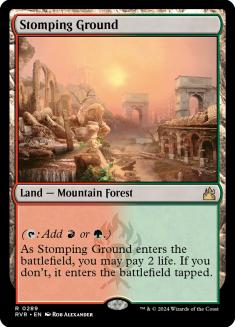

I’d wanted one more basic, but it’s not actually necessary, and between cutting one of my “special” lands or running the 39th land, I opted to shave the
Forest and not worry any further.
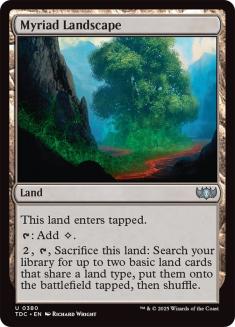
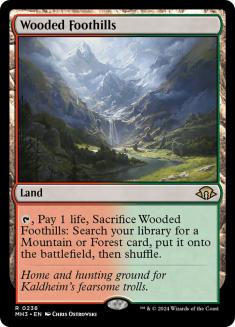
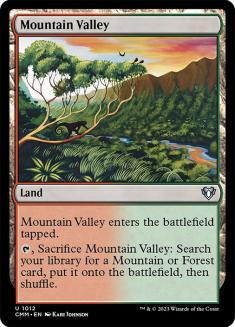

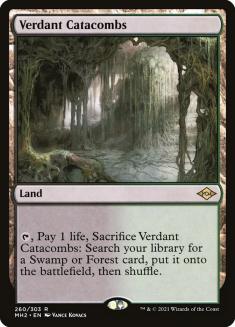
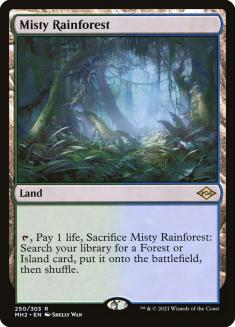
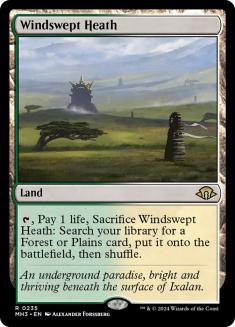
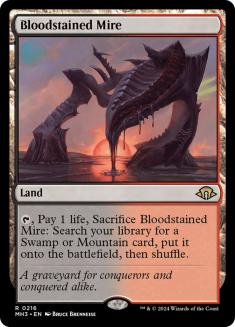
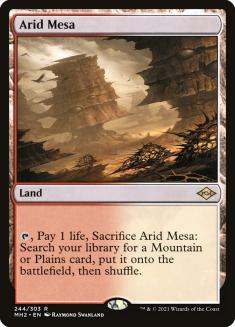
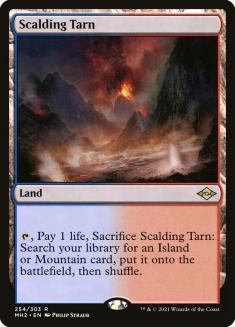

As long as they keep letting me get away with playing off-colored fetchlands, I’ll keep doing it. Nine fetchlands should be more than enough to reliably
draw one in every game where I also I get either Crucible or Loam, and in seeing just how many of them I can get if I try, I also decided to revisit my other new Commander deck and find a
slot for Titania, Protector of Argoth somewhere in the 99. That’s a lot of power just sitting there for free when you’re already halfway optimized to play
her anyway, and I couldn’t justify leaving her out of the party just because I don’t have a second copy of her. I’ll already be slotting over the Crucible
of Worlds to borrow from that deck whenever I want to play this one, I can grab the Commander then too…
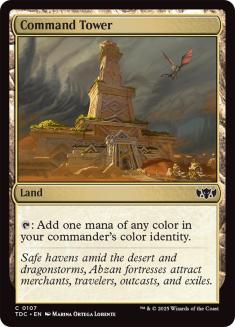
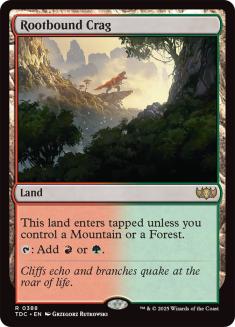
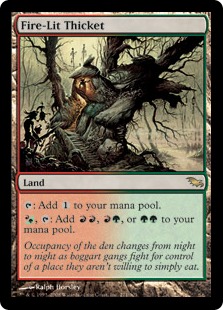
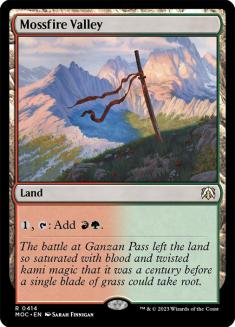
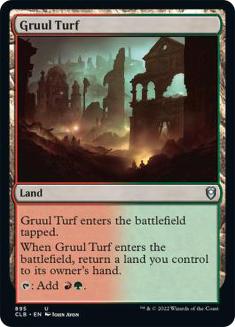

Five more dual lands that are all pretty low-key, none of them ask for life out of me, and the only one that comes into play tapped is my clan’s Ravnica
bounceland, which I’d play ten of if they’d let me.
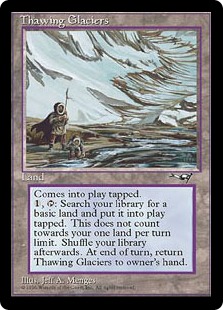
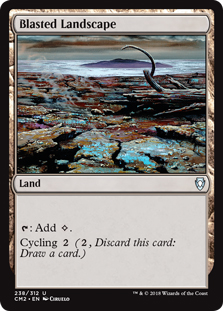
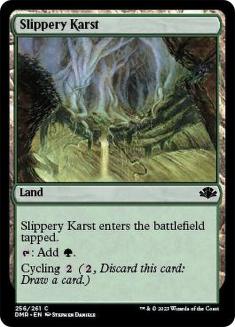
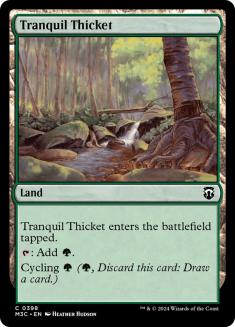
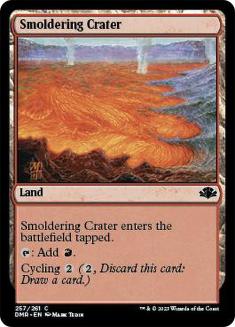
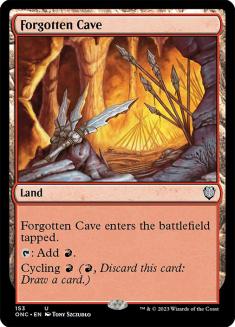

Thawing Glaciers is obviously pretty crazy if your plan is to trade cardboard over time with your opponent – getting as much mana as you could possibly
need more-or-less for free over that same stretch of time is an exceptionally good deal. The five cycling lands are all perfectly okay with Crucible of
Worlds and start letting me get a bunch of resources for free every turn if I draw one with Life from the Loam – or just flat-out draw a bunch of cards
once we hit multiples.
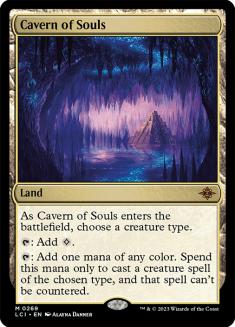
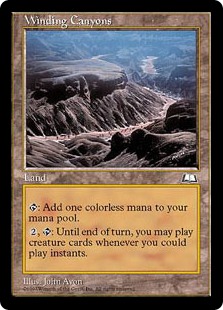
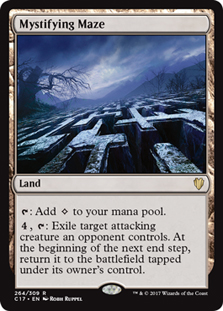
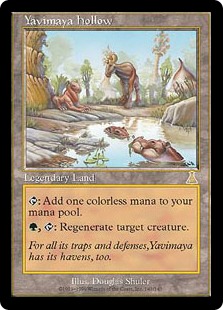
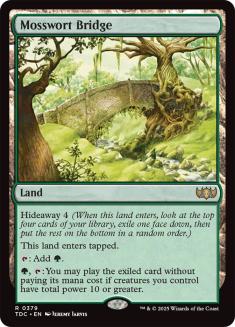
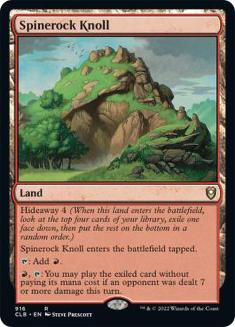

Cavern of Souls isn’t really an “advantage land” in the way I like to think of them, but I like building non-blue decks with opposing blue decks
in mind. Winding Canyons likewise “isn’t card advantage,” but it is time advantage; holding your creatures off until the end of your opponent’s
turn greatly increases the likelihood that any creature you play will actually do something since you’re guaranteed at least one attack before the
sorcery-speed removal comes online to wipe the board. Considering that board wipes happen early and often in this format, Winding Canyons helps make sure
your cardboard is actually worth a card – and it helps maintain relevance in the later stages of the game too, by turning your otherwise sorcery-speed
creature spells into possible instant-speed blockers.
The rest are pretty straightforward: red/green gets the best two hideaway lands for Commander, Mystifying Maze is a solid bit of defense added to your
arsenal for a very low opportunity cost – unlike Maze of Ith, this land taps for mana – and Yavimaya Hollow can help keep creatures on the table in the
face of mass removal spells again and again. We’re going to end up being quite aggressive, I think, but the protective capabilities of that land are so
cheap that we can’t possibly justify leaving it out.
Artifacts of the Matter
A little goes a long way, but I’m bored right now of some of the “automatic” additions that would otherwise suggest themselves here. I’ve played Godo as my
commander a lot, and for this deck I’d rather stay away from equipment cards rather than go digging for them – so no Lightning Greaves, though we’ll still
end up playing a few of them in order to borrow some useful abilities like lifelink – gaining a life buffer while we’re beating down can replace a fair bit
of defense here.
We’ll start with adding that Crucible of Worlds, then get the boring additions out of the way – Sensei’s Divining Top and Sol Ring – to move on to meatier
things. The few equipment I do want here, I’ve picked because of their beneficial attributes with our heavily Draconic creature-base – Lifelink
goes great with creatures that have a very high damage output, and the +3/+0 and trample granted by Loxodon Warhammer will make sure that our biggest
threats get through and deal a lot of damage while they’re at it. The other one is Basilisk Collar – Dragons are very good at dealing a bit of extra damage
here and there if they try to, and giving them deathtouch as well as lifelink makes them far better equipped to keep our opponents’ boards clear of nasty
threats.
The last five are these:
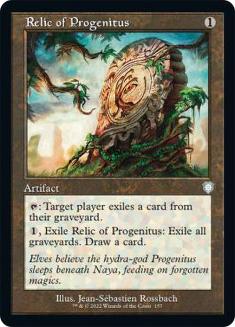
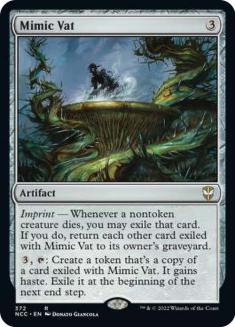
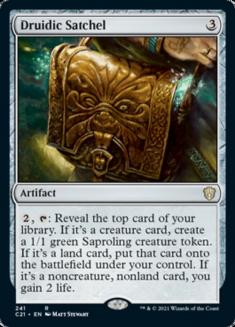
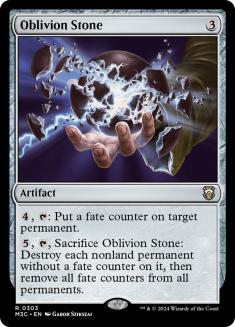
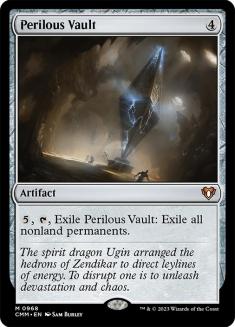

Druidic Satchel is sort of fractional card advantage – it clears lands off the top of your deck, thus digging us towards real spells about one-third of the
times you activate it – and the other two out of three activations will still give you something for your mana, even if it’s just some life or a
1/1. It gets much stronger when you can alter the top card of your library – such as with our plentiful fetchland-centric manabase – or better yet when you
can see the top card, as a few of our green cards will allow. Relic of Progenitus is here because we don’t want to lose to opposing graveyards and
are barely using our own, so it’s only really costing us a slot, and it can potentially hose quite a few opponents without needing to pick and choose who
to damage. The other three are pretty common by comparison – Mimic Vat is one of the best recurring effects that you can find in this format, to the point
where I think it’s better than most planeswalkers, while Oblivion Stone and Perilous Vault will help us deal with problems that our color combination would
otherwise have a hard time answering.
Support Spells
No matter how many of them you have or how big they are, Dragons aren’t going to win the game by themselves. Having a high creature count and a solid top
end is great, but Atarka is about as top-end as a threat can get, so we will always have powerful action when we get to the later stages of the game. Not
just dying before you get there is key though, and this is why a lot of decks of this ilk will tend to focus on ramping – if you move that end-game two
turns forward off of mana acceleration, that’s two more turns of beating down on naughty combo players before they can kill you. I think the card-advantage
ramp spells are solid enough to include, but otherwise I want a mix of haymakers that can end the game, removal spells that can let us live that long, and
cards that specifically address a creature deck’s general weakness to non-creature threats.
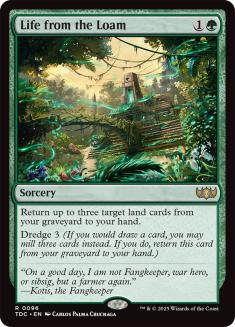

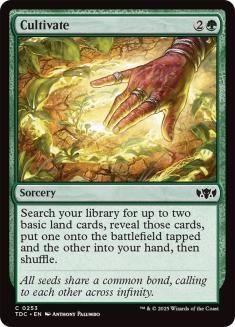
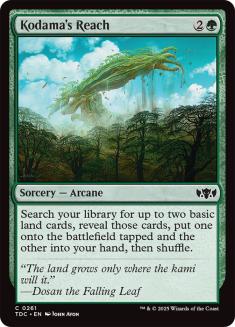
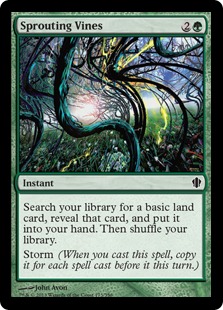

Life from the Loam is obviously great with the mix of lands we’ve already included, and while I don’t really want to play a lot of ramp, Explore is too
good for me to pass over – the acceleration doesn’t cost you a card, so it’s still an acceptable draw later in the game, unlike the tons and tons of cheap
ramp spells we could also have played but opted out of (like Rampant Growth and Search for Tomorrow). Cultivate and Kodama’s Reach are the sorts of spells
I really like for this task – I enjoy the fact that green can readily hunt up two lands to put into play, but I don’t really want to pay four mana for
that, as you would have to with Explosive Vegetation and its cousins. And I like those two so much that I want to try something else that’s been on my mind
lately – I’ve been trying to find room for more of the oddball storm spells lately, and I don’t think it takes very much to turn Sprouting Vines into a
worthwhile number of cards. Just one player doing something and another player having to respond is enough to get you three lands out of it, and while that
may be a bit unlikely in the early stages of the game, even then you can get two lands so long as one player does anything.
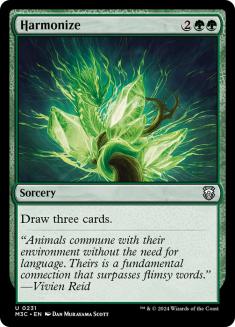
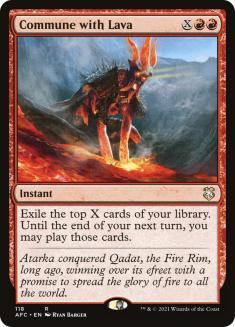
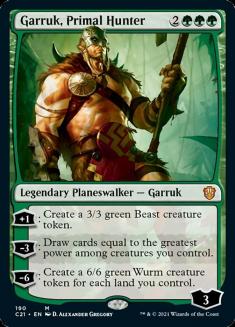
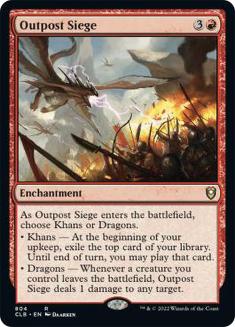
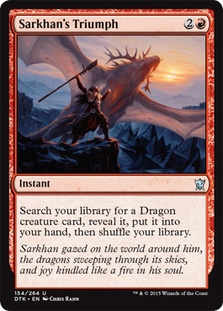
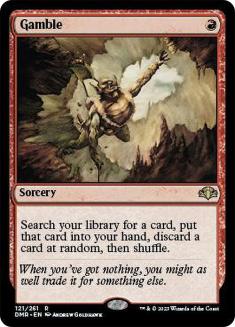

These are my card-advantage and tutoring effects of choice; we could fit a few more, but these are basically the best ones without relying overly much on
cards like Mind’s Eye that draw a bullseye on us. The tutoring is very light – Gamble can always get Life from the Loam and can probably get
whatever else I might need at the moment, so I’m trying to forgive it for a lot of previous bad experiences by putting it to work here, while the new
Dragon-tutor, Sarkhan’s Triumph, seems at least as good as another card I’d been pondering, Time of Need, and we’ll have plenty of targets for it here.
Harmonize is about the best we can expect from this color combination, and honestly, Garruk, Primal Hunter is just trying to be a second copy – it may
sometimes do other stuff if making 3/3s would work out against opponents’ relatively empty boards, but I’m hoping to cash it in immediately to draw cards
and don’t necessarily expect to draw a huge amount of them. For drawing a huge amount of cards, well, we’ll give another new card a try – Commune with Lava
is actually pretty exciting for a proactive deck, since Gruul is not exactly known for its Sphinx’s Revelations, and casting this for five or six should
let us get a bunch of action on our next turn and play all of it without feeling bad because we can’t cast them all. While it would be far more dangerous
in a big-mana deck that wanted to fire it or Genesis Wave off for twenty or more, those are the sorts of decks I actively avoid being anywhere nearby, so
I’m happy to use it fairly to reload when we’ve hit the top of our downright-reasonable curve.
While thinking about planeswalkers, I considered adding Chandra, Pyromaster just for her card-advantage effect… then I realized we could accomplish
exactly the same thing with Outpost Siege and never have to actually defend against an opposing attack. It feels downright weird to have anything even
close to a Phyrexian Arena in this color combination, but I’m happy to take it.
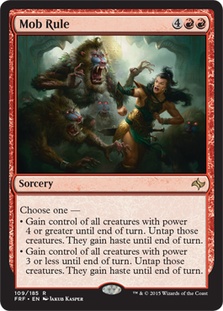
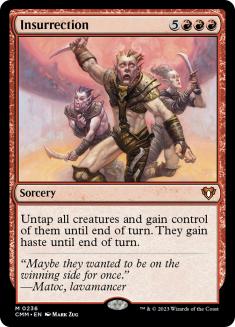
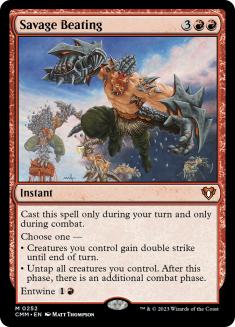
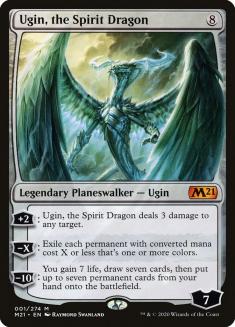
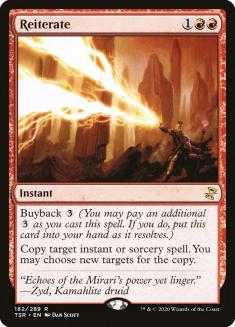
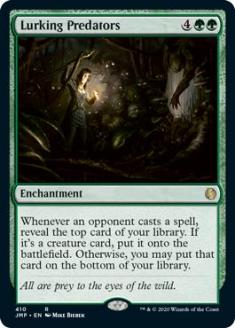

The deck’s big big top-end. Half of these are huge effects that should end the game immediately or at least KO multiple players – Mob Rule and Insurrection
are lethal if your opponents have anything close to a decent board position, while Savage Beating is lethal if you do. The other half are potent advantage
engines – Ugin can wipe the board of key threats and then get a ton of value with the plus ability, or just start building loyalty right from the get-go
and draw seven cards off the ultimate. Reiterate is a bit harder to fit into any specific definition since it’s only as good as the spells you get to
target with it, but it’s a strong card for always having something to do and being able to protect yourself against huge problem spells. Lurking Predators
is a little more obvious, but we have enough creatures and top-of-deck manipulation for it to hit with fair regularity, so it will reward us over just a
few turns of playing Magic with extra free threats our opponent has to deal with.

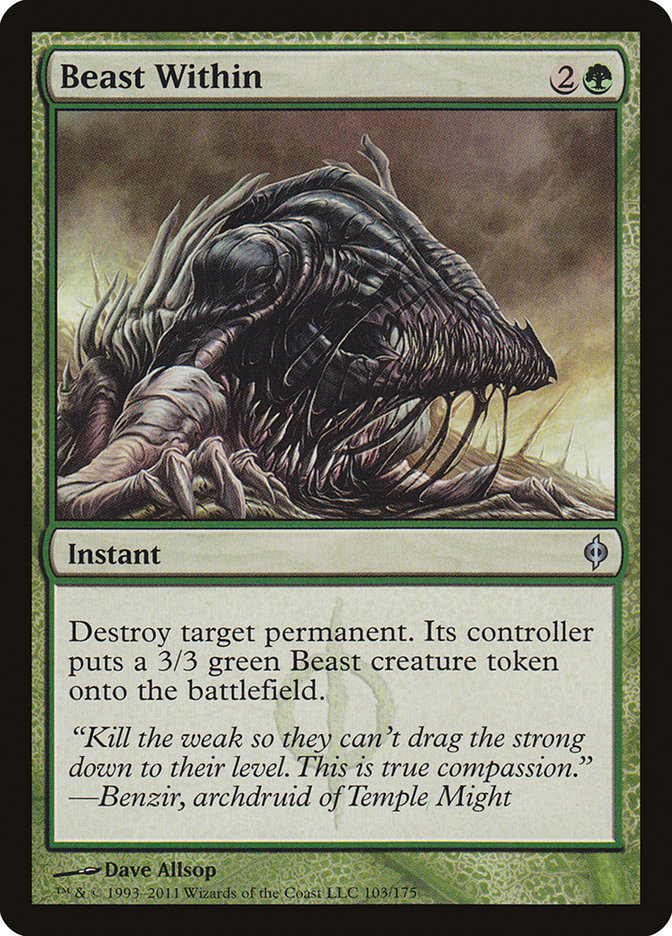
I don’t want a lot of spot removal, but I want it to be both cheap and flexible. Both of these can hit any card in play at an attractive rate, even if that
does mean hand-waving past some of the downsides that can happen off of the rest of the text written after “smash your opponent’s best thing at instant
speed.” I’ve yet to be truly punished off of a Chaos Warp, though I’ve certainly seen it happen – that one time back in the day when somebody got an
Emrakul off of it was pretty laugh-worthy – and even if it happens sometimes, I think the risks are well worth fading. There aren’t exactly a lot of red
cards that can kill an enchantment or green cards that can kill a creature, the potential drawbacks of something bad happening later are not nearly as bad
as “that thing is killing me right now.”
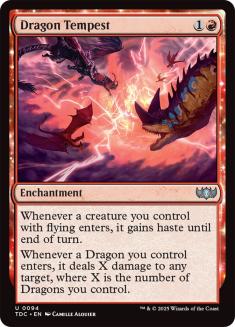
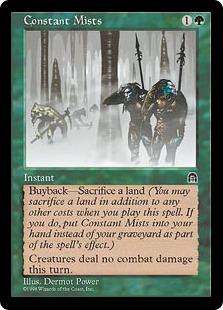
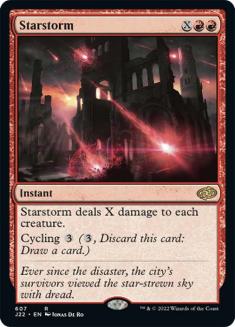
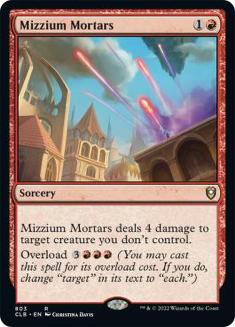
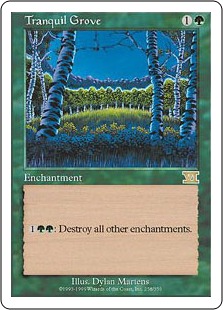
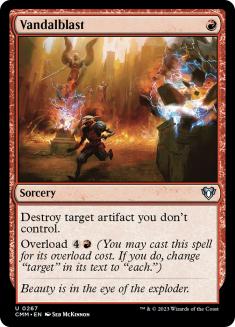

These last few slots fill out the deck’s second-tier removal slots, and we trade off versatility for raw power. Each of these excels at something, but it
just happens to be that something is very narrow – if you really want to Fog, Constant Mists is the best there is at what it does, just like
Vandalblast is excellent for handling problem artifacts without hitting our own cards and Tranquil Grove is great at keeping enchantment-heavy opponents
from dominating the board. We aren’t playing very many of our own, so it’ll regularly hurt our opponents far more than it does us, and if enchantments are
a problem you run into in your playgroup, being able to cast Tranquility over and over again off of the same card is downright mean.
I’m okay with being mean when it comes to wrecking boards full of Propaganda effects and Sterling Groves, and most of the cards that are tough for us to
beat will be enchantments, so Tranquil Grove really should pull its own weight. Starstorm is situational mass removal at instant speed, and scalable enough
that we can leave our Dragons untouched while it takes down an unruly mass of Plant tokens falling off of an Avenger of Zendikar. Mizzium Mortars is
mediocre removal at two mana but pretty crazy at six mana; I’d thought about fitting in a Bonfire of the Damned, then realized this would do all of the
same work for much cheaper 99% of the time since the turn you’d be able to miracle it is not always the turn it’d be right to cast your removal spell. The
last spell added, Dragon Tempest, is another new card I’m intrigued by and want to give a fair chance – I’ve been calling it “Fliers of Yavimaya,” and I
think it’s much better than even I’m giving it credit for since it is a powerful haste effect and potentially repeating removal at the same time,
adding a strong enters-the-battlefield trigger to the dozen or so actual Dragons we’ll be adding to the deck.
Monster Mash
This leaves us room for 26 creatures, and I wanted to play all of the best Dragons that appealed to me out of the Commander Box of Doom. Counting
Changelings, half of the creatures will be Dragons and the other half will be Gruul creatures that intrigue me. The Changeling is mostly cheating – Taurean
Mauler is an extremely solid card for its low mana cost, and my first pass of the deck had been trying to rectify a half-Dragon/half-Beasts tribal build
that exploited Contested Cliffs too, so big Changelings were a good way for me to try and mesh those different themes together before I realized I was
trying too hard and pulled them out. The Mauler stays though, because it’s just too big for three mana to cut – an early drop that gets a +1/+1 counter for
every opposing spell cast can very quickly get out of hand.
The other dozen actual Dragons were these:
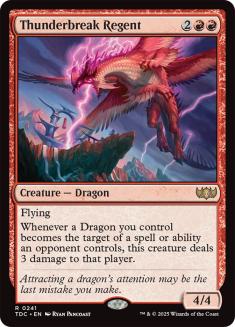
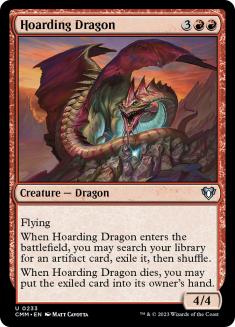
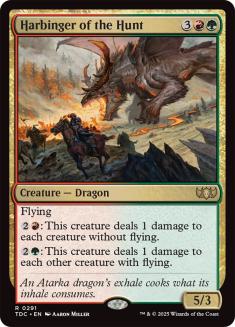
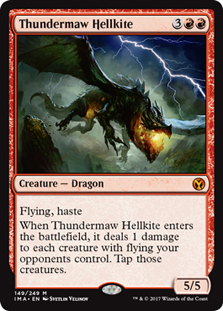
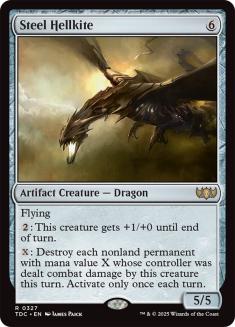
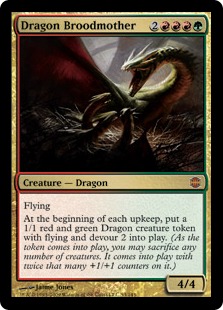
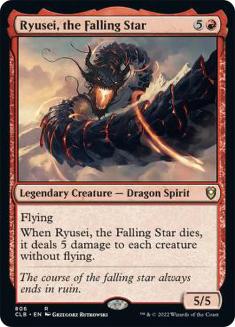
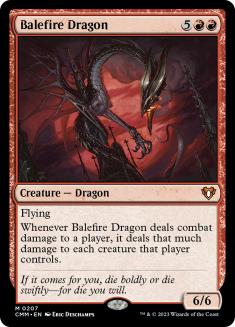
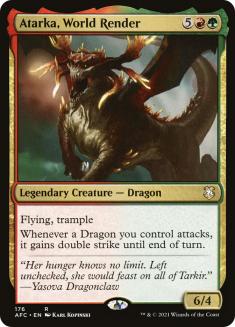
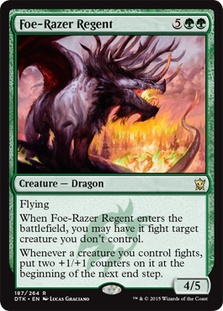
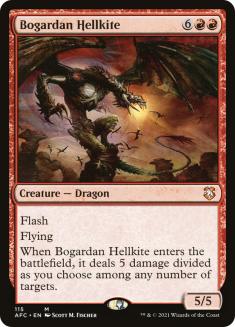
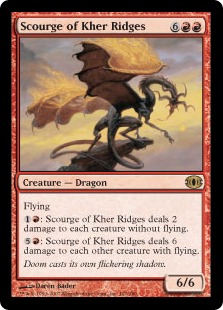

Mostly I wanted to focus on getting some extra removal out of my creature base, so stuff that I’d otherwise shy away from (like Ryusei, the Falling Star)
suddenly became attractive because this time around I wouldn’t lose most of my own creatures to the death trigger. All of the extra-damage creatures are
great with lifelink and nightmarish with deathtouch, both Scourge of Kher Ridges and newcomer Harbinger of the Hunt are pretty twisted with a Basilisk
Collar equipped to them, and both still make it quite difficult for opponents to utilize small-creature strategies or token armies without the extra help.
Dragon Broodmother has to be pretty crazy with Dragon Tempest, and just getting to live that dream once would be more than enough reason for me to play the
Broodmother even though she’s not usually interesting enough to me.
Our monsters all help to keep our opponents on the back foot, just like our commander does – having a Bogardan Hellkite effect at the helm of your deck is
a potent start to a powerful theme. But Dragons suck at having a mana curve – we’ve got one three-drop by literally cheating (thanks, Changeling!)
and one four-drop that doesn’t require a lot of fidgeting to make it worthwhile – otherwise we’d need to manage with 2/2 fliers in Commander or worry about
things like threshold, the next-best inclusion is probably Rakdos Pit-Dragon since it’s at least a 3/3 even if it only flies sometimes. Once we
get to five mana we start to really develop the tribe, and everything’s definitely worth the cardboard – we could easily have played twenty dragons without
cutting the quality, I opted not to play a lot of similarly-great cards just because I didn’t want to cram the slots full of top-end things and forget to
do stuff on turn 2. But to get worthwhile early drops, we have to leave the Dragon tribe behind.
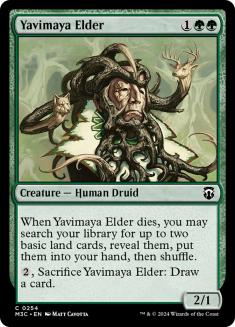
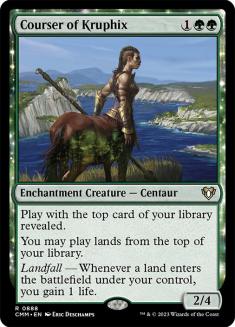
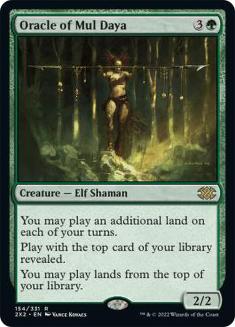
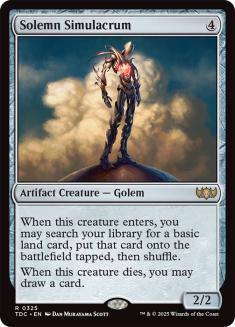
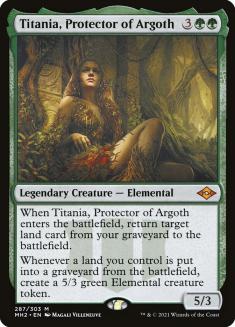
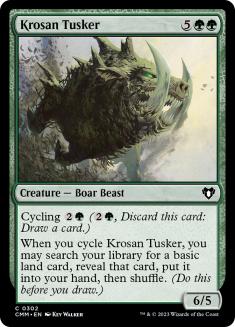

These are the other half of our mana-ramping effects, they were all picked solely because their effects could generate extra resources for free without
costing us a card while doing it. Krosan Tusker is likewise a holdover from when I was trying to Beast Mode people with Contested Cliffs, but I liked the
small land-search plus draw effect enough to keep it in this iteration as well – but the best version of that effect is unquestionably Yavimaya Elder,
which takes more mana but gets two lands and a card instead. Anything that puts three cards in your hand for that cost is going to be good in
Commander, even if two of them are lands – and heck, I want them to be lands, I’m intentionally leaning on effects like this to keep my Commander
affordable. Courser and Oracle both interact favorably with the fetchlands and top-of-deck manipulation effects, so they should be pretty strong since
we’re playing a decent number of support cards to help them out, while Titania feels kind of like an odd sock – we have enough fetchlands to turn her into
a reliable ramp effect, but don’t really have much in the deck synergizing her 5/3 token creation. It turns out that making free 5/3 beaters is synergy all
by itself, and she’s just accidentally awesome with elements of the deck I’d already settled on playing like Loam and Crucible.
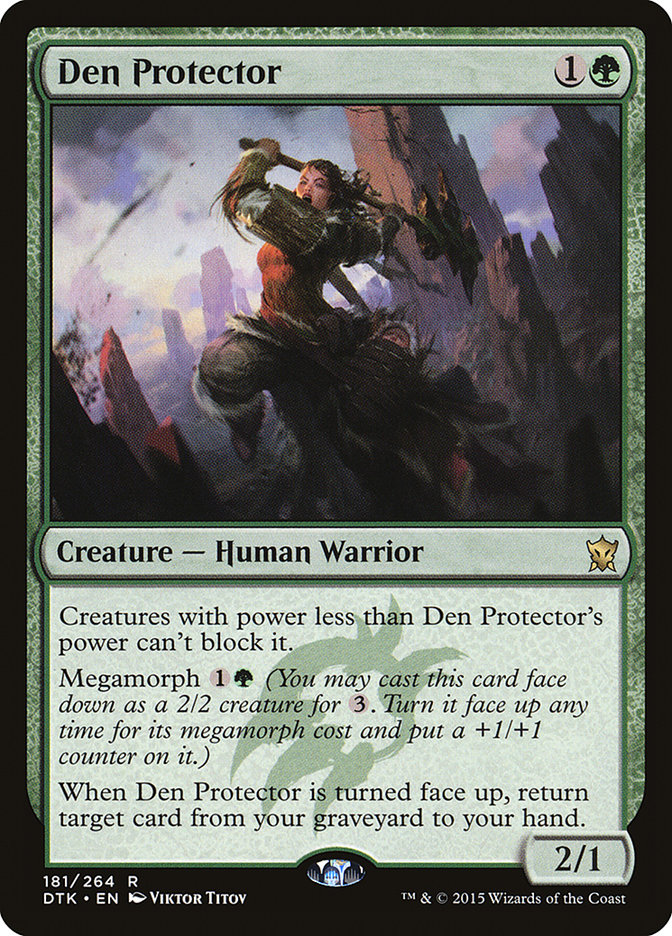
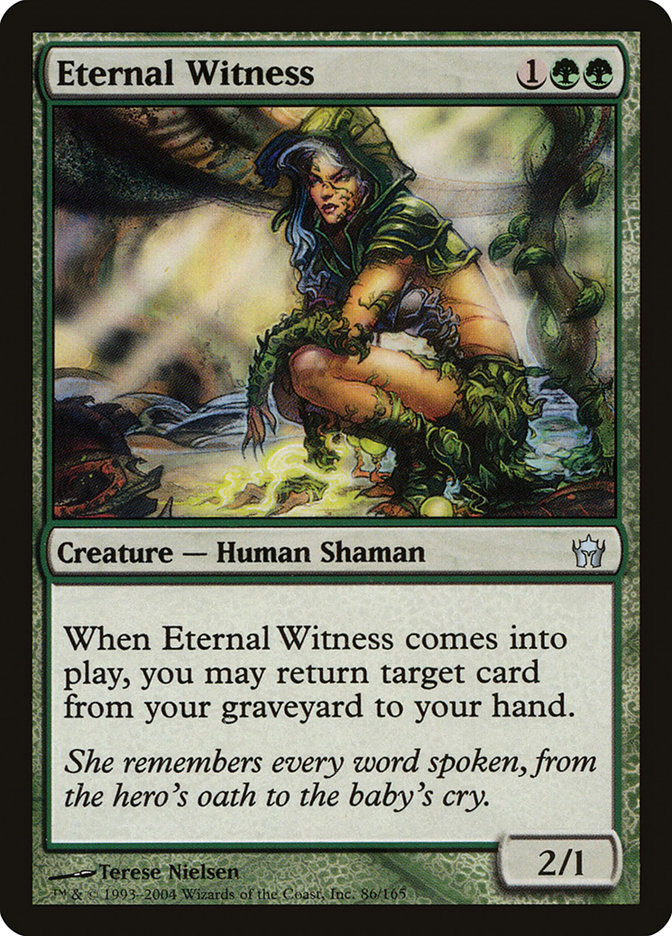
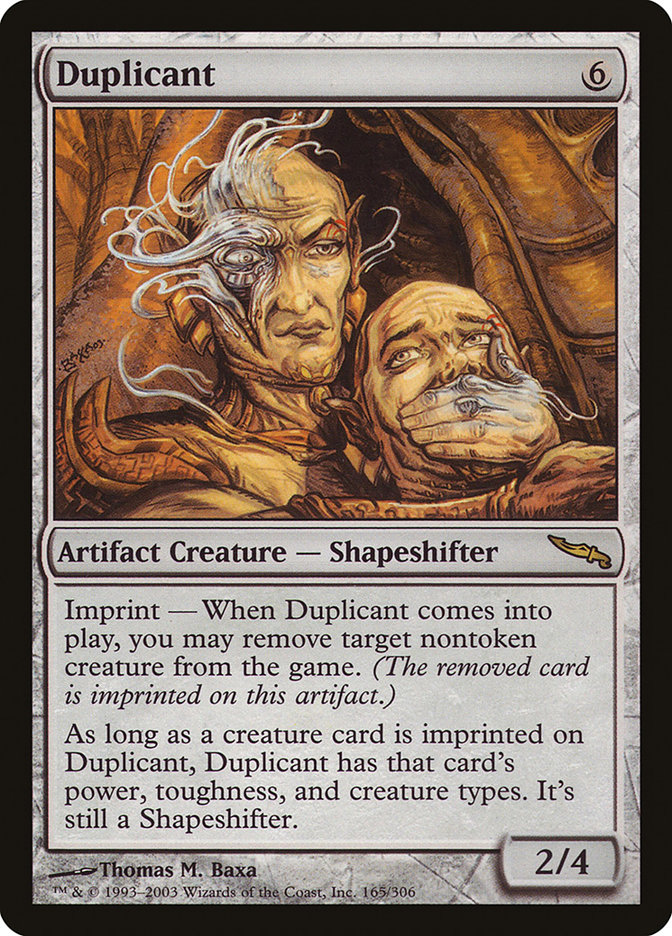
Not the most interesting cards, it’s true, since they’re all Commander staples – or will be soon, as is the case with the new Mega Morphing Eternal
Witness! I’d hoped I could at least have an anecdote from the Prerelease since my seeded pack came with a promo Den Protector as its foil rare, but this
format felt so fast that just playing it on turn 2 felt correct – and the one time I morphed it, I never had the time or inclination to unmorph it and get
a huge spell back, I always had plenty of expensive action in hand and just re-bought an Evolving Wilds. I’d initially tried to keep it more interesting
here – the “Beast Mode” build was trying to unmorph things and buy back Deathmist Raptor to use with Contested Cliffs – but that stopped working real fast, and Den Protector is the only morph creature left standing at the end of things.
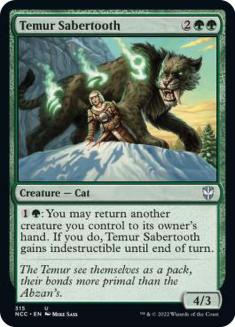
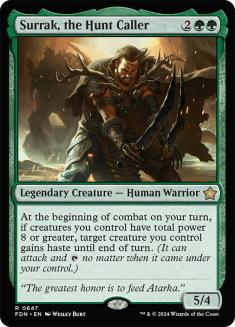
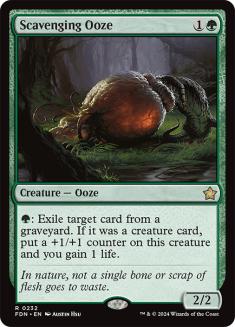
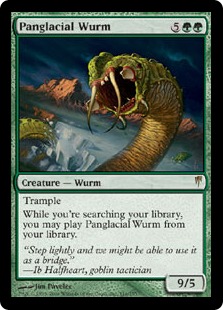

Panglacial Wurm was included for much the same reason Titania made the cut – this deck is fetchland-heavy and wants to get more action off of fewer cards
later on in the game if possible, so we can still do stuff without running out of cardboard. Lategame fetchlands can generate nine power out of
nowhere if you have a Panglacial Wurm in your deck, but they can’t if you don’t, so the decision seemed pretty obvious this time. Temur Sabertooth is great
with the enters-the-battlefield effects that many of the Dragons generate and just decent at weathering removal spells otherwise, so it’s part card
advantage and part Wrath protection while also being a decent body at an attractive rate.
Surrak, the Hunt Caller is another card picked here mostly because it is from Dragons of Tarkir. I wanted to have fun with some of the new cards
first and “pick the best card for the best deck” second (if at all). Not needing the equipment cards like Lightning Greaves because we have new options
through Surrak and Dragon Tempest piqued my curiosity, and Surrak plus basically any other creature in the deck should hit that Formidable threshold right
off the bat, so we get to stay nice and aggressive with plenty of haste triggers still around. And the last addition was Scavenging Ooze, based solely off
of the fact that people do stuff with graveyards that make us sad – we don’t have countermagic to stop Living Death, and there’s otherwise not much we can
do against a stocked graveyard and a Yawgmoth’s Will, so having something that was a decent body we could work with and provided this extra
utility as well was a pretty easy choice. It doesn’t hurt that it can still be a huge creature later in the game despite being a two-mana 2/2, and being
good later in the game was most of my reasoning in all of the card choices for this deck. Any piece of cardboard I draw needs to be great in the lategame
still or at least put a card back in my hand to be worth my trouble, which is why a lot of on-color sacred cows got slaughtered and left by the wayside
here – who plays a green deck but leaves out Sakura-Tribe Elder, after all?
In each of those absent cards’ cases, an overarching focus on drawing real cards in the later game and getting at least a two-for-one on my mana
acceleration effects helped guide my choices – or maybe they were just even less fun than the boring and derivative Commander staples I’d already stomached
playing, which is why there’s no Genesis Wave, Praetor’s Council, et cetera, et cetera.
Putting it all together gave us the following beatdown monstrosity:
Creatures (26)
- 1 Solemn Simulacrum
- 1 Krosan Tusker
- 1 Ryusei, the Falling Star
- 1 Eternal Witness
- 1 Yavimaya Elder
- 1 Duplicant
- 1 Panglacial Wurm
- 1 Bogardan Hellkite
- 1 Scourge of Kher Ridges
- 1 Taurean Mauler
- 1 Dragon Broodmother
- 1 Oracle of Mul Daya
- 1 Hoarding Dragon
- 1 Steel Hellkite
- 1 Scavenging Ooze
- 1 Balefire Dragon
- 1 Thundermaw Hellkite
- 1 Courser of Kruphix
- 1 Titania, Protector of Argoth
- 1 Atarka, World Render
- 1 Temur Sabertooth
- 1 Harbinger of the Hunt
- 1 Foe-Razer Regent
- 1 Thunderbreak Regent
- 1 Den Protector
- 1 Surrak, the Hunt Caller
Planeswalkers (2)
Lands (38)
- 5 Forest
- 1 Wooded Foothills
- 1 Thawing Glaciers
- 6 Mountain
- 1 Slippery Karst
- 1 Smoldering Crater
- 1 Mossfire Valley
- 1 Windswept Heath
- 1 Bloodstained Mire
- 1 Yavimaya Hollow
- 1 Tranquil Thicket
- 1 Forgotten Cave
- 1 Mountain Valley
- 1 Winding Canyons
- 1 Blasted Landscape
- 1 Gruul Turf
- 1 Stomping Ground
- 1 Mosswort Bridge
- 1 Spinerock Knoll
- 1 Fire-Lit Thicket
- 1 Rootbound Crag
- 1 Arid Mesa
- 1 Misty Rainforest
- 1 Scalding Tarn
- 1 Verdant Catacombs
- 1 Mystifying Maze
- 1 Command Tower
- 1 Cavern of Souls
- 1 Myriad Landscape
Spells (33)
- 1 Sensei's Divining Top
- 1 Sol Ring
- 1 Constant Mists
- 1 Kodama's Reach
- 1 Starstorm
- 1 Crucible of Worlds
- 1 Gamble
- 1 Oblivion Stone
- 1 Loxodon Warhammer
- 1 Savage Beating
- 1 Sprouting Vines
- 1 Insurrection
- 1 Tranquil Grove
- 1 Life from the Loam
- 1 Reiterate
- 1 Harmonize
- 1 Relic of Progenitus
- 1 Lurking Predators
- 1 Basilisk Collar
- 1 Explore
- 1 Cultivate
- 1 Mimic Vat
- 1 Beast Within
- 1 Chaos Warp
- 1 Druidic Satchel
- 1 Mizzium Mortars
- 1 Vandalblast
- 1 Perilous Vault
- 1 Outpost Siege
- 1 Mob Rule
- 1 Dragon Tempest
- 1 Sarkhan's Triumph
- 1 Commune with Lava

I’ll give this particular Dragonlord a few weeks to prove its worth, and see how all of the cards are performing before I consider jumping over to another
Elder Dragon Legend – Silumgar does all the things black and blue decks love to do, which makes him either awesome or unnecessary depending on how you
think about the problem, while Dromoka still piques my curiosity and asks me an interesting question: “can you build a G/W deck that you don’t hate?”
The answer is still probably “no,” but at the very least it’s an interesting question…
Want to submit a deck for consideration to Dear Azami? We’re always accepting deck submissions to consider for use in a future article, like Erik’s Animar, Soul of Elements deck or Roni’s Oros the Avenger deck. Only one deck submission will be chosen per article, but being selected for the next edition of Dear Azami includes not just deck advice but also a $20 coupon to StarCityGames.com!
Like what you’ve seen? Feel free to explore more of Dear Azami here, in the Article Archives! Feel free to follow Sean on Facebook… sometimes there are extra surprises and bonus content to be found over on his Facebook Fan Page, as well as previews of the next week’s column at the end of the week!
And feel free to check Jess’s own Command of Etiquette column on Hipsters of the Coast for more Commander and casual content!

